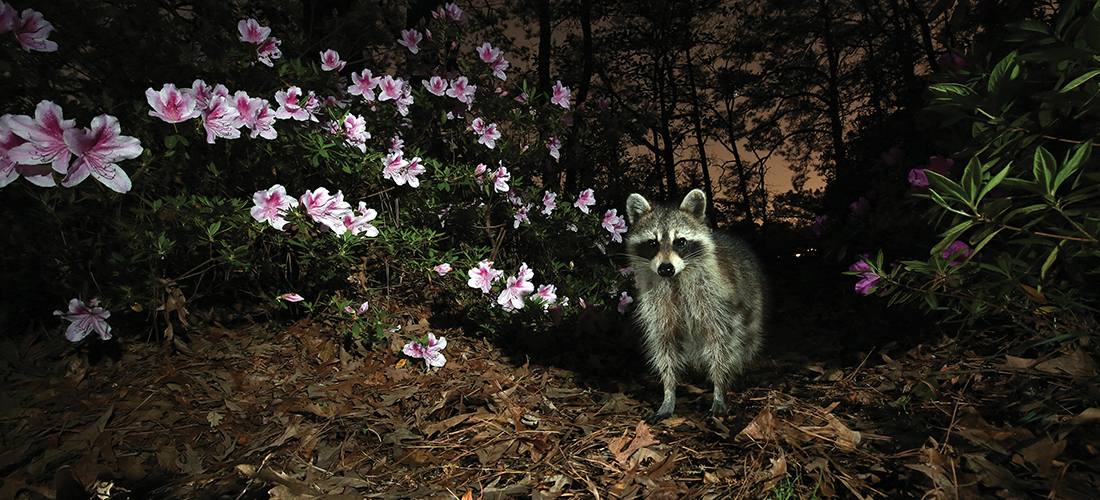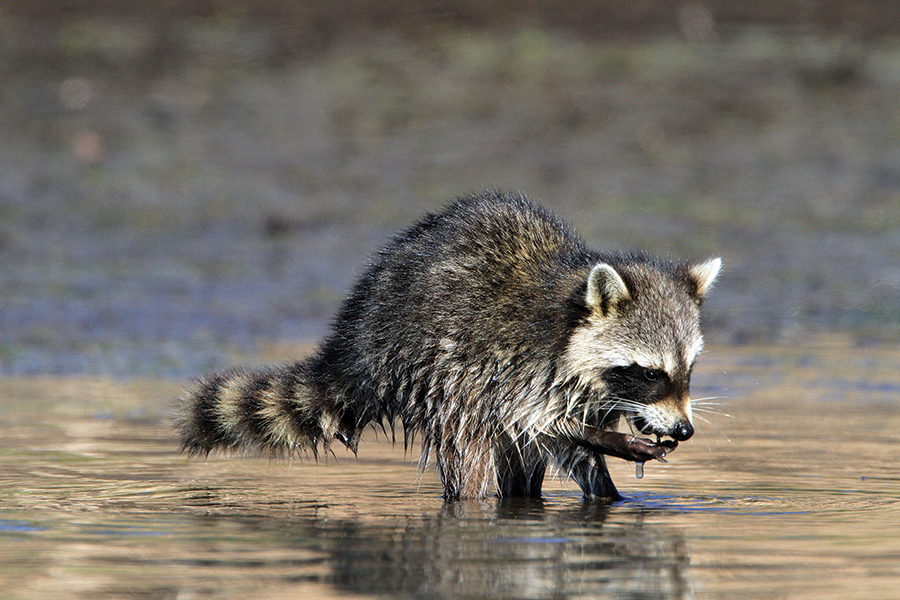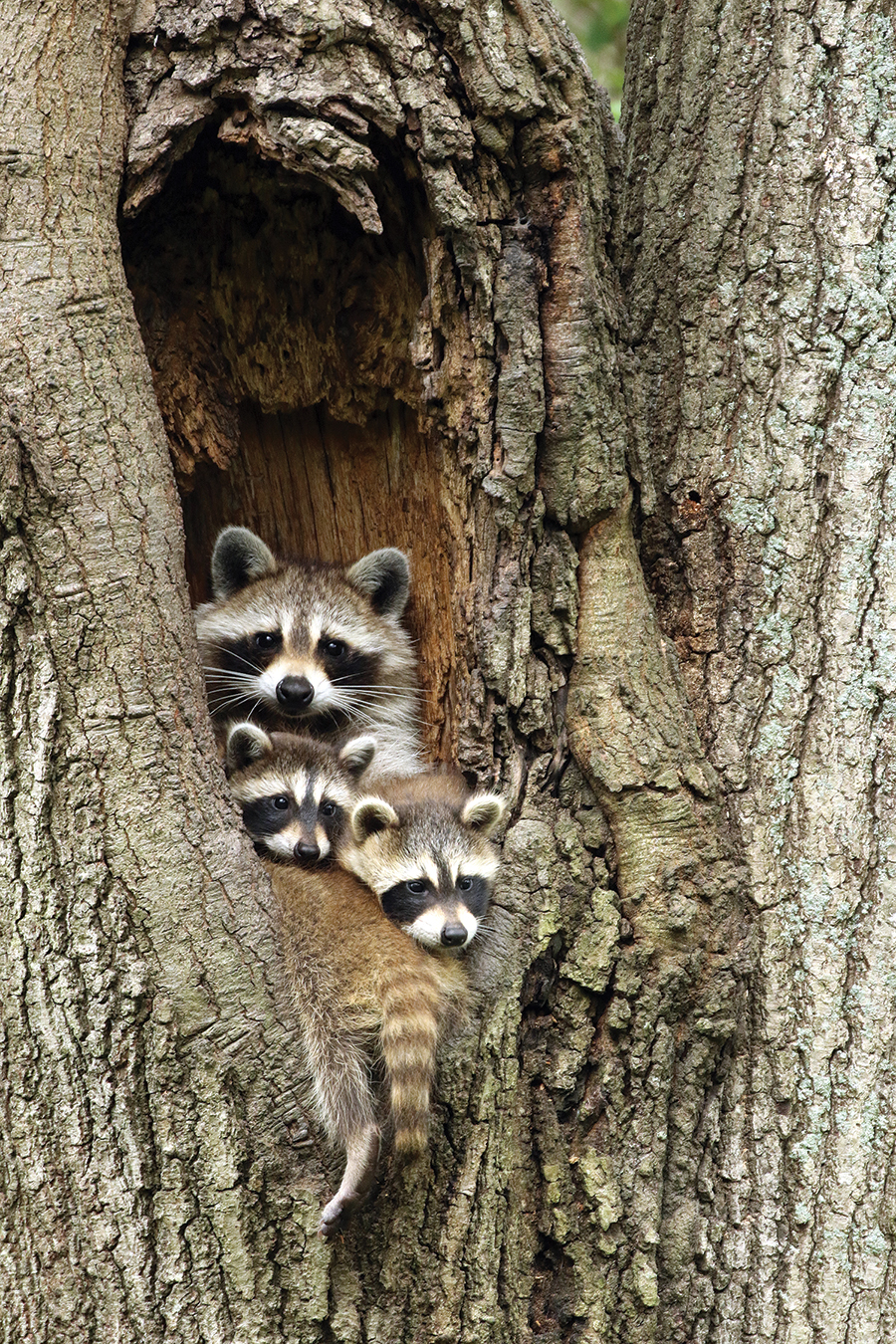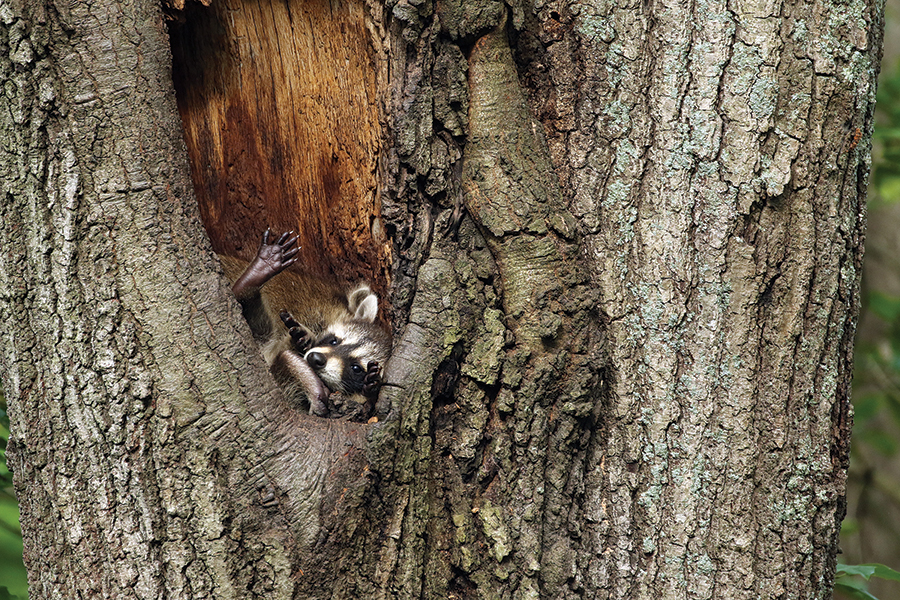
Backyard Bandits
Observing the private lives of a raccoon family
Story and Photographs by Todd Pusser
As I was walking past our living room window on a bright, winter’s night, something caught my eye. Out in the front yard, beneath a birdfeeder, stood a bandit. The full moon high above illuminated its distinctive hunched back, pointed ears, dog-like snout and bushy tail. Dexterous paws busily scooped up sunflower seeds from the ground, spilled earlier in the day by hungry cardinals and gray squirrels.
I stood quietly and watched as the raccoon turned its attention to the birdfeeder hanging high above its head. Standing on its hind legs, while simultaneously extending its front legs upward, the raccoon grasped the feeder with its paws and slowly rocked it back and forth, emptying more seed onto the ground. The ease at which the precocious critter performed the task left me with the distinct feeling it had done this before.
Over the next 15 minutes, the raccoon repeated this behavior numerous times, eventually emptying the birdfeeder of its contents. Satiated, or perhaps simply because there was nothing left to eat, the raccoon slowly ambled toward the edge of the yard and disappeared into the night, no doubt looking for more mischief elsewhere.
With their striped tails, large eyes, and distinctive black and white markings wrapped around a cute puppy-dog face, raccoons are among the most recognizable of North American mammals. Incredibly adaptive and intelligent, they make their homes in a wide assortment of habitats ranging from remote forests to heavily urbanized cities.

Growing up in rural Eagle Springs, along the western edge of the North Carolina Sandhills, raccoons were always present on the landscape but I rarely saw them. My most memorable childhood encounters with the crafty critters were among the pages of Sterling North’s Rascal and Wilson Rawls’ Where the Red Fern Grows, two beloved novels that still feature prominently on my bookshelf. It was not until I moved to a densely populated Virginia city that I was able to observe raccoons, outside in their natural environment, with any detail.
Our 3-acre suburban yard bordered a tidal river and contained a mixture of loblolly pines and hardwood trees. One impressive tree, a tall sweetgum, with a large, open cavity about 15 feet off the ground, stood just outside our second-story bedroom window.
One April morning a few years back, I noticed a raccoon curled up in a tight ball at the cavity entrance. The animal remained there for several days, rarely moving, except to occasionally lift its head and stare at me when I mowed the lawn. After a couple of weeks, I began to worry that the animal might be sick. Toward the middle of May, I woke one morning to find three tiny, young raccoons peering out from the cavity along with the larger animal. The raccoon had not been sick, as I had feared, but was simply pregnant and had given birth to a trio of impossibly cute kits whose antics provided hours of entertainment.
Being able to observe the intimate details of the lives of animals is a rare treat, and so it became a morning routine, with a cup of coffee in hand, to watch the raccoon family for a couple of hours before work. Mother raccoons are attentive, loving and tender, and this one proved to be no exception. Throughout the day, she constantly groomed and nursed her young. As the kits grew, she would often leave the increasingly cramped tree cavity and bask quietly on a nearby tree limb, obviously treasuring a moment of solace from her rambunctious young.
Over time, her routine became predictable. She stayed nestled in the tree cavity with her young for much of the day, occasionally basking on nearby tree limbs when it was hot. At night, she ventured out of the cavity to look for food, always returning by sunrise. Toward the middle of summer, she began to take her young on her nightly forays.


The raccoon family utilized the entire yard but frequented the azalea garden and the patch of dirt beneath the bird feeders, where they eagerly gobbled up spilled sunflower seeds. Several times that summer, I observed the young foraging elbow deep in the river and marveled at the dexterity of their paws as they “washed” their food.
By early fall, mother raccoon weaned her kits and sent them on their way. I am not sure where they eventually settled, but on occasion, I would see a young raccoon dash across a nearby neighborhood street late at night in front of my car and wonder if it might be one from our yard.
We ended up moving away from that riverfront property over six years ago. From time to time, I still think about that mother raccoon and wonder if she might still be alive. With abundant food and adequate shelter — which our yard had in spades — raccoons can live for well over a decade. It is entirely possible she is. Perhaps this spring will find her raising another family of young kits inside the cozy tree cavity just outside our old bedroom window.
Thinking about that now, I can’t help but smile. PS
Naturalist and photographer Todd Pusser grew up in Eagle Springs. He works to document the extraordinary diversity of life both near and far. His images can be found at www.ToddPusser.com.





